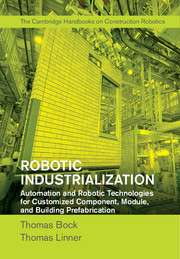 Robotic Industrialization
Robotic Industrialization Book contents
2 - Automation and Robotics in Building Component Manufacturing
Published online by Cambridge University Press: 05 August 2015
Summary
Building component manufacturing (BCM) is to be distinguished from the manufacturing of medium/high-level building blocks, such as building modules (Chapter 3) and large-scale prefabrication (LSP, see Chapters 4 and 5). This chapter deals with the BCM of parts, assemblies and lower level components and outlines machine systems and manufacturing processes with a particular focus on automation and robot technology. The components and manufacturing systems outlined are based on the processing one of four main materials: ceramic, concrete, wood, and steel. Each is discussed in a separate section. The sections are structured to acquaint readers with the entire manufacturing process, from the processing of raw materials to the production of parts and, finally, to the assembly of those parts into components. The necessary manufacturing methods are outlined to provide an understanding of the basics, identify the specific properties, and describe the variety of processing methods for each material. The chapter focuses on the specific automated machinery, robot systems, end-effectors, jigs, fixtures, workflows, and process layouts necessary within each material category to make, handle, assemble, and process elements and parts into components.
Roughly similar manufacturing methods are used within all of the four material categories in the production and assembly of building components. First, the materials (with the exception of wood) are obtained from a mixture of various basic substances. To achieve permanent union of the mixture of these substances, a transformation process (e.g., curing or hardening process) is required and specific thermal, atmospheric or pressure conditions must be created. Next, thanks to processes such as, for example, extrusion and moulding, the mixed material can be brought into the required form (e.g., basic, raw parts such as bricks, steel bars, and profiles). Since the described transformation of raw materials into parts doesn't take into account the specifications of the future use, further treatment, manipulation and assembly of these simple elements with other elements is required to produce building components with specifications, features, performances and connectors that allow its use in a larger, more complex, modular systems of components, modules, units and buildings.
- Type
- Chapter
- Information
- Robotic IndustrializationAutomation and Robotic Technologies for Customized Component, Module, and Building Prefabrication, pp. 7 - 65Publisher: Cambridge University PressPrint publication year: 2015
- 1
- Cited by


